Straw Rocket Activity & Engineering Challenge
Newton’s Three Laws of Motion & Straw Rockets
In this straw rockets activity, your kids will build straw rockets and then use them to demonstrate Newton’s Three Laws of Motion.
We have provided a straw rocket template, along with instructions, explanations, and activity pages to record “lab results.”
Allow time to let your children take this straw rocket activity further and explore some of their own ideas and rocket designs.
NASA has a great history of rockets that makes a nice addition to this study.
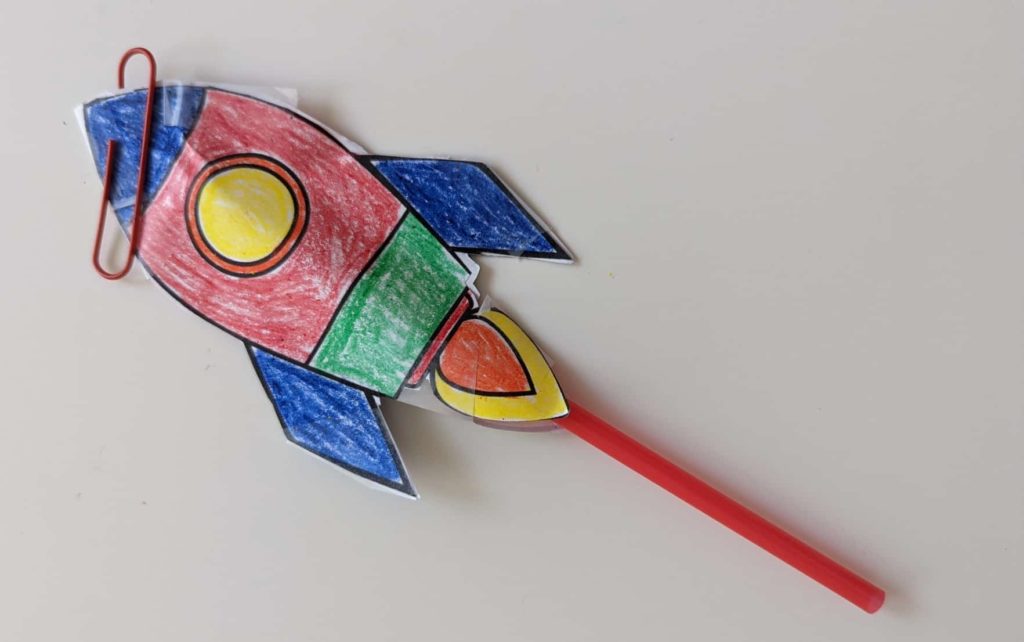
Straw Rocket Activity & The Three Laws of Motion
Forces are all around us. We live with gravitational force all the time. There are five forces. Three of them–gravitational, magnetic, and electrical —are the forces we can easily observe. Two other forces exist within the nucleus of an atom. These are nuclear forces and weak interaction forces.
Most people remember Sir Isaac Newton as the man who first explained gravity. Newton, also, gave us his three laws of motion.
Newton’s first law of motion states that objects at rest tend to stay at rest, and objects in motion tend to stay in motion at the same speed and in the same direction unless acted upon my an outside force. This is sometimes referred to as the Law of Inertia.
Inertia is an object’s resistance to change in its state of motion whether at rest or moving. Objects retain their inertia unless acted on by a force. Force can be applied in many ways.
Newton’s Second Law of Motion states the greater the mass of an object, the more force it will take to accelerate the object.
Newton’s Third Law of Motion states that for every action, there is an equal and opposite reaction.
Try this simple experiment to test Newton’s first law of motion. It will help you and your students get a good idea of what the Law of Inertia is all about and how applied force, frictional force, and the force of gravity affect objects.
Demonstrating Newton’s First Law of Motion with a Straw Rocket
Building the Straw Rocket
DOWNLOAD THE ROCKET TEMPLATE AND OTHER PRINTABLES FOR THIS LESSON–SEE BELOW.
Straw Rocket Activity for Kids
Materials
- `1 Straw rocket template Download your copy by requesting it below.
- 1 Wide straw
- 1 Narrow straw
- 2-4 Paper clips The dollar store has medium-sized ones that work perfectly!
- Tape and/or glue
- Crayons
- Scissors
- Tape measure, yard stick, or meter stick
- Pencil
Instructions
- Print out the rocket template. If using the black and white version, color in the rocket.
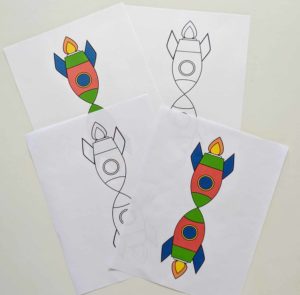
- Cut out along the outside lines without cutting apart at the tip.
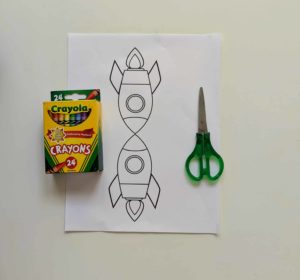
- Cut the wider straw or pipette to fit between the two rockets.
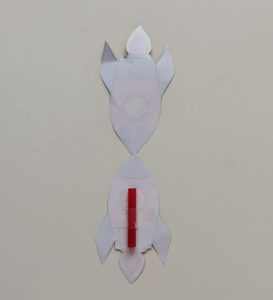
- Tape the wider straw or pipette to the non-patterned side of the rocket. It’s important to REALLY seal up the edges, including the areas around the flame.
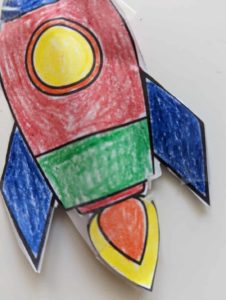
- Cut the thinner straw to 6” length.
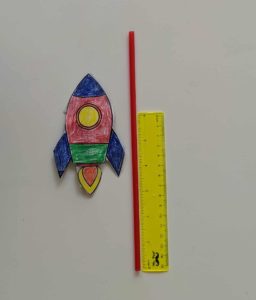
- Slide one paper clip to the nose cone. Once you get some measurements with the paper clip during this experiment, then remove the paper clip. What happens?
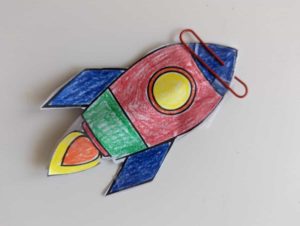
- Slide the thinner straw into the straw in the rocket and blow (this represents the force of air pressure.)
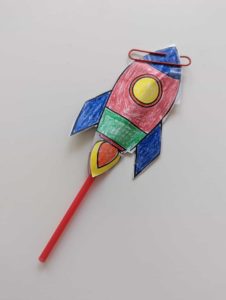
Let’s Get Launching Our Straw Rockets!
The distance traveled with each launch is going to vary depending on how much force is used when breathing out to launch the rocket. The angle of the rocket at launch will affect how far it travels. Lastly, the mass of the rocket will affect the distance traveled.
The Center of Mass & Your Straw Rocket
Why did we add the paper clip to the nose cone of the straw rocket?
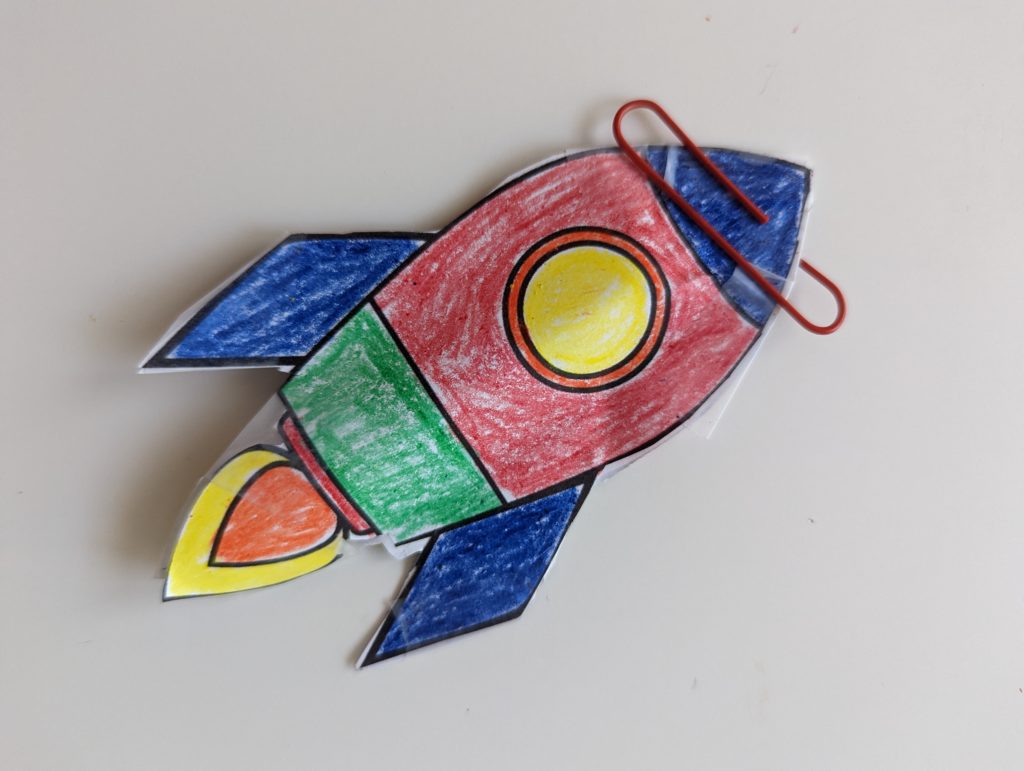
So, if you were to balance the rocket nose cone point on your finger, that would be the center of mass. By adding the weight of the paper clip, we are creating that center of mass.
The center of mass adds stability to the rocket. This is why the rocket flies better when we have the paper clip on the nose cone.
Dependent and Independent Variables
If your child is not familiar with dependent and independent variables, let’s review:
An independent variable is the variable that is changed in an experiment. In this part of our activity, the angle of launch, the weight on the body of the rocket, and the amount of air pressure or velocity is what we are going to change.
The dependent variable is what we are going to measure. In all three parts of this experiment, the distance the rocket travels is our dependent variable.
Let’s Test it Out
Let’s test out the three laws of motion, as best we can. We will be testing velocity, mass, and angle of the rocket. While it’s difficult in our set-up to launch the rocket at the exact angle and with the exact air pressure (breath forces through the straw), this experiment will provide some understanding into the three laws of motion.
Three Laws of Motion Experiment Procedures
PLEASE NOTE: You can download this entire lesson write-up, worksheets, templates, and student worksheets by entering your email below.
To download this lesson and all of the worksheets, please enter your email address below. You will be subscribed to our newsletter, where we share resources such as this. You may unsubscribe at any time by clicking the Unsubscribe link in our emails.
Each child or, if working in groups, each group will need:
- A measuring tape
- A straw rocket
- The instruction sheets
- The lab worksheets
- Paper clips
- Optional: masking tape to mark a spot on the floor to always stand so distance can be measured with a consistent starting point.
Fill in the First Law of Motion on the Lab Worksheet.
Place a piece of masking tape on the floor to mark a place to stand at each launch.
Practice launching the rocket ensure there are no air leaks on the sides and that the launcher (straws) are working properly.
Launch the rocket straight ahead without any upwards angle. Then, measure the distance it traveled.
Record the distance on the lab sheet.
Angle the straw up slightly (about 45 degrees). Launch the rocket and measure the distance it traveled.
Record the distance on the lab sheet.
Angle the straw up past the previous launch angle. Launch the rocket and measure the distance it traveled.
Record the distance on the lab sheet.
There is an extra space on the recording sheet if you do another test.
Fill in the What Happened? Section on the Lab Worksheet. (Which traveled farthest? Which traveled the shortest distance? What do you conclude?)
What Happened?
As we mentioned above, Newton’s First Law of Motion states that objects at rest tend to stay at rest, and objects in motion tend to stay in motion at the same speed and in the same direction unless acted upon by an outside force.
The rocket stays on its launcher and at rest until a force (your child blowing on the launcher) acts upon it. The rocket then moves off of the launcher and flies until the friction of the air and the gravitational force acts upon it and sends the straw rocket to the ground.
Newton’s Second Law of Motion and the Straw Rocket Activity
Newton’s Second Law of Motion states that the greater the mass of an object, the more force it will take to accelerate the object.
Follow the instructions on the What to Do pages for testing angle, mass, and velocity–or testing the Three Laws of Motion.
When we add the paper clips, one at a time, we have to breathe out with greater force to launch the rocket the same distance each time.
Questions to Ask After the Second Test
When mass (weight) was added to the rocket, did it travel a greater or shorter distance? Why do you think that is?
What forces were acting on the rocket both when you launched it and when it was traveling through the air? Gravity, air pressure from blowing on the launcher, and air resistance as it traveled through the air.
To review, what was the independent variable (the variable we changed)? The weight of the rocket.
What was the dependent variable (what we measured)? The distance traveled.
How was The Second Las of Motion demonstrated in this part of the experiment?
Third Law of Motion and the Straw Rocket Activity
Newton’s Third Law of Motion states that for every action, there is an equal and opposite reaction.
In this activity when we blow into the straw, the air pressure inside the straw increases (that is the action) and this causes the rocket to launch through the air (which is the reaction.)
Follow the instructions on the What to Do pages for testing the Third Law of Motion.
When we apply more air pressure (velocity) we have to breathe out with greater force to launch the rocket the same distance each time.
Questions to Ask After the Third Test
When greater velocity was added to the rocket, did it travel a greater or shorter distance? Why do you think that is?
What forces were acting on the rocket both when you launched it and when it was traveling through the air? Gravity, air pressure from blowing on the launcher, and air resistance as it traveled through the air.
To review, what was the independent variable (the variable we changed)? The weight of the rocket.
What was the dependent variable (what we measured)? The distance traveled.
Related post: 50+ STEAM Activities
This is a great resource for tons of engineering project ideas!

I hold a master’s degree in child development and early education and am working on a post-baccalaureate in biology. I spent 15 years working for a biotechnology company developing IT systems in DNA testing laboratories across the US. I taught K4 in a private school, homeschooled my children, and have taught on the mission field in southern Asia. For 4 years, I served on our state’s FIRST Lego League tournament Board and served as the Judging Director. I own thehomeschoolscientist and also write a regular science column for Homeschooling Today Magazine. You’ll also find my writings on the CTCMath blog. Through this site, I have authored over 50 math and science resources.


